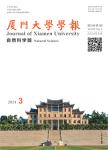Experimental Study on the Milling of a Ti Beta 21S
Experimental Study on the Milling of a Ti Beta 21S出 版 物:《厦门大学学报(自然科学版)》 (Journal of Xiamen University:Natural Science)
年 卷 期:2002年第41卷第S1期
页 面:76-页
核心收录:
学科分类:08[工学] 080502[工学-材料学] 0805[工学-材料科学与工程(可授工学、理学学位)]
基 金:ProjectsupportedbyAeronauticalScienceFoundation (0 1H5 2 0 4 4)
主 题:titanium alloy milling tool wear cutting force
摘 要:Ti Beta 21S (Ti-15Mo-2.7Nb-3Al-0.2Si) was devel op ed by TIMET in 1989. It is a metastable beta titanium alloy that offers subs tantial weight reductions over other engineering materials. Compared with common beta Ti alloys, it offers the high specific strength, good cold formability, im proved oxidation resistance, elevated temperature strength, creep resistance, an d thermal stability. Besides the common characters of titanium alloy, such as po or heat diffusivity, low elastic modulus, Ti Beta 21S has very high specific str ength and good plasticity. These make Ti Beta 21S a difficult-to-cut material. In this paper, the tool wear and cutting force in milling process were studied by experiment. The tool wear experiments were carried out in order to determine the opticmum cutting parameters and tool material, and the purpose of cutting fo rce measurement is to explain the cuting phenomenon and tool wear results in fur ther degree. The machinablity assessment of Ti Beta 21S with different cutting t ools was given out. As a difficult-to-cut material, Ti Beta 21S should be mill ed with sharp-edged tool at lower cutting parameters to avoid severe wear of th e tool. Coolant should be used to conduct cutting heat. Proper tool material sho uld be selected, for example, the cutting force by YS25 tool is 20 percent lower than that by YG8 at the milling speed of 80 m/min. The roughness of flank and r ake surface is another important factor that affects tool wear and cutting f orce, and Ra should be below 0.2 μm while milling Ti Beta 21S. These results wi ll be useful in the actual production process, and have thrown new light on the cutting of difficult-to-cut material.



